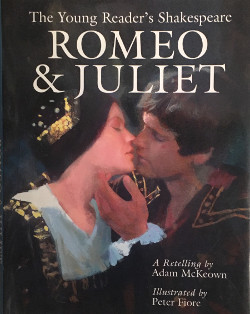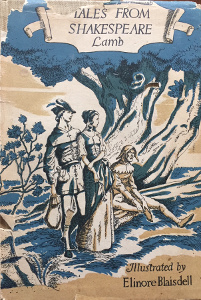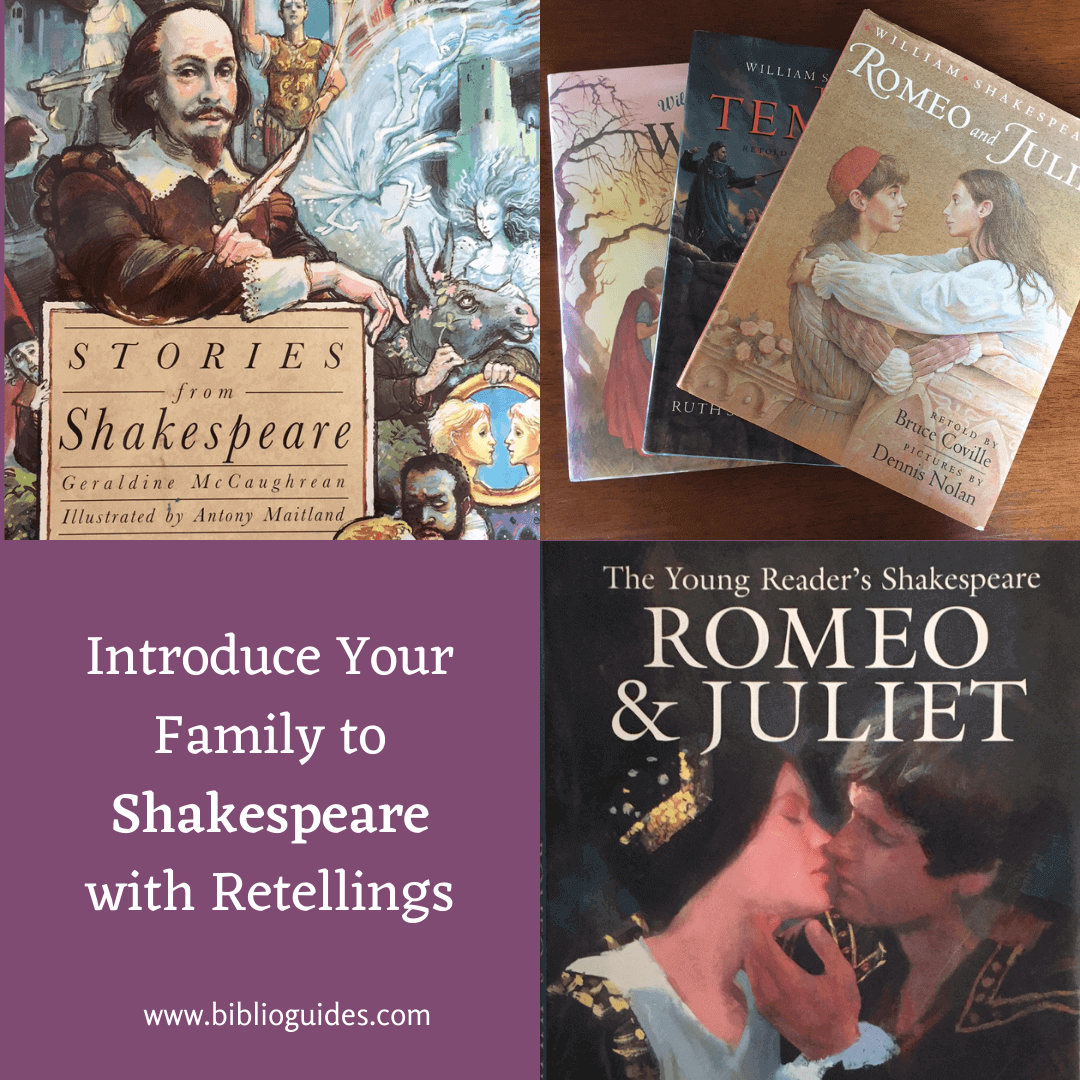“To be, or not to be; that is the question…”
“All the world’s a stage…”
“A rose by any other name would smell as sweet.”
“To thine own self be true.”
“Neither a borrower nor a lender be…”
Do any of these phrases sound familiar? Shakespeare’s words frequently slip into our lives, influence our conversation, and color our language without us even being aware. As we gain familiarity with Shakespeare and his works we come to understand the origin of these quotes, phrases, and concepts, and we are better able to appreciate and apply them using the context under which they were written. Not only does this knowledge enrich our general vocabulary, but Shakespeare’s multiple layers of meaning, deep understanding of the human condition AND the ability to portray it in both political intrigue and personal drama, help us better understand our current world. Clothing, methods of communication, geographical awareness, and a vastly greater understanding of our physical world may separate us from his time, but our intimate, daily interactions with each other really haven’t changed. Shakespeare continues to be relevant, applicable, and meaningful in our current state of affairs. One of Shakespeare's best friends, Ben Jonson, said it best in a poetic tribute, "He was not of an age, but for all time."
Yet, it is the rare reader who is able to decipher any Shakespeare play on the first reading. So it can be very helpful to gain a better understanding of the plot's twists and turns by reading a retelling of the play before attempting to read the actual play itself. Depending on the age and maturity of your children, you may choose to read a retelling and then read or watch the original play shortly after. Or, you may choose to read the retelling, and wait to read or watch the original play until your children are older. In either case retellings are an excellent way to introduce yourself and your children to Shakespeare. Becoming familiar with the characters and plots of Shakespeare's plays reduces any anxiety or fear that you may have from being unfamiliar with the language.
Each author listed below retells Shakespeare’s plays in a different style and chooses to highlight and interpret his words in different ways. Keep in mind that, even in retelling, the stories often convey the gravity of each play, which may or may not be appropriate for your children. I personally have not felt that my children are ready for either Macbeth or Hamlet, as well as some of the histories, but this is certainly a decision to be made by each parent when pre-reading and is dependent on a child’s maturity as well as the play's content.
Because all retellings are not created equal, I’ve created my own criteria for evaluating them:
- Incorporation and usage of Shakespeare’s original words
- Lyrical and storytelling quality versus a statement/summary of facts
- Maintaining the surprise element and allowing the reader to interpret the themes and characters themselves
- Complexity and variability of language along with breadth of vocabulary used
- Illustrations—abstract versus realistic versus whimsical (younger children probably benefit from a more realistic perspective given the complexity of the stories)
- Cost of obtaining it
In order to analyze the writing style of each of the following authors, I chose to read Hamlet and A Midsummer Night’s Dream in succession by each author listed below.
Bruce Coville
 Retelling 7 of the most well-known plays, Twelfth Night, Romeo and Juliet, Macbeth, Hamlet, A Midsummer Night’s Dream, A Winter’s Tale and The Tempest (each are separate books), Mr. Coville, along with an illustrator, adapts the story for young readers and listeners. I find his frequent use of Shakespeare's actual words woven into the storyline particularly lovely so that children can associate specific phrases with the actual play. For example, in Hamlet, he quotes “To be or not to be…”, “Though this be madness, yet there is method in it”, and, “Sweets to the sweet” along with many other noteworthy lines. Illustrators are variable depending on the book. Some are quite abstract (Macbeth and Hamlet) while others are whimsical and fun (Twelfth Night and A Midsummer Night’s Dream). These can be difficult to find and expensive—grab them if you ever see them at library sales or thrift stores. For ages 8-12 or elementary students.
Retelling 7 of the most well-known plays, Twelfth Night, Romeo and Juliet, Macbeth, Hamlet, A Midsummer Night’s Dream, A Winter’s Tale and The Tempest (each are separate books), Mr. Coville, along with an illustrator, adapts the story for young readers and listeners. I find his frequent use of Shakespeare's actual words woven into the storyline particularly lovely so that children can associate specific phrases with the actual play. For example, in Hamlet, he quotes “To be or not to be…”, “Though this be madness, yet there is method in it”, and, “Sweets to the sweet” along with many other noteworthy lines. Illustrators are variable depending on the book. Some are quite abstract (Macbeth and Hamlet) while others are whimsical and fun (Twelfth Night and A Midsummer Night’s Dream). These can be difficult to find and expensive—grab them if you ever see them at library sales or thrift stores. For ages 8-12 or elementary students.
Edith Nesbit
 Ms. Nesbit authored two books, Beautiful Stories from Shakespeare and The Children's Shakespeare. There are several different editions with various illustrators. I happen to be partial to the handsome volume which was the “official text for members of the National Junior Shakespeare Club” and illustrated by Max Bihn, but her retellings are the same in any of the books. Her narrations of the plays are gently and "beautifully" written with a fairytale-like quality to the story. Although she generously quotes Shakespeare, she omits the most disturbing aspects of each play which makes these retellings most appropriate for the younger audience, ages 6-12 or elementary students. Due to the many editions available, some contain lovely illustrations while other editions have no illustrations at all. Vintage copies can be expensive, but paperback editions of her retellings can be purchased easily or read online at archive.org or The Baldwin Project.
Ms. Nesbit authored two books, Beautiful Stories from Shakespeare and The Children's Shakespeare. There are several different editions with various illustrators. I happen to be partial to the handsome volume which was the “official text for members of the National Junior Shakespeare Club” and illustrated by Max Bihn, but her retellings are the same in any of the books. Her narrations of the plays are gently and "beautifully" written with a fairytale-like quality to the story. Although she generously quotes Shakespeare, she omits the most disturbing aspects of each play which makes these retellings most appropriate for the younger audience, ages 6-12 or elementary students. Due to the many editions available, some contain lovely illustrations while other editions have no illustrations at all. Vintage copies can be expensive, but paperback editions of her retellings can be purchased easily or read online at archive.org or The Baldwin Project.
Geraldine McCaughrean
 Her Stories From Shakespeare retells 10 plays with careful detail, but she quickly identifies the themes, character flaws, and character strengths for the reader, leaving little for the reader to deduce for him/herself. This approach is helpful for a first introduction to a play for ages 10-14 or late elementary/middle school students, particularly if the reader finds understanding Shakespeare cumbersome and difficult. The characters are also identified in a list at the beginning which is not present in many other retellings. I found these easy to read and ideal for the audience mentioned above, but readers who want to interpret Shakespeare’s words for themselves might find these disappointing. Illustrations are generally realistic, but unremarkable. This retelling is easily purchased in paperback or hardcover.
Her Stories From Shakespeare retells 10 plays with careful detail, but she quickly identifies the themes, character flaws, and character strengths for the reader, leaving little for the reader to deduce for him/herself. This approach is helpful for a first introduction to a play for ages 10-14 or late elementary/middle school students, particularly if the reader finds understanding Shakespeare cumbersome and difficult. The characters are also identified in a list at the beginning which is not present in many other retellings. I found these easy to read and ideal for the audience mentioned above, but readers who want to interpret Shakespeare’s words for themselves might find these disappointing. Illustrations are generally realistic, but unremarkable. This retelling is easily purchased in paperback or hardcover.
Leon Garfield
 This author narrates 24 plays in Shakespeare Stories and Shakespeare Stories II which are illustrated by Michael Foreman. These are the lengthiest and most detailed of all the retellings, using an engaging combination of modernized language and frequent quotes from the plays themselves. I find these retellings to be the most approachable for the average older student if the length of reading is not a barrier. Illustrations are abstract but captivating and appropriate given the style of his writing. These retellings are commonly found in library sales and inexpensive online as well. For ages 12-18 or middle/high school students.
This author narrates 24 plays in Shakespeare Stories and Shakespeare Stories II which are illustrated by Michael Foreman. These are the lengthiest and most detailed of all the retellings, using an engaging combination of modernized language and frequent quotes from the plays themselves. I find these retellings to be the most approachable for the average older student if the length of reading is not a barrier. Illustrations are abstract but captivating and appropriate given the style of his writing. These retellings are commonly found in library sales and inexpensive online as well. For ages 12-18 or middle/high school students.
Adam McKeown
 Young Reader’s Shakespeare: Hamlet, Julius Caesar, Romeo & Juliet, Othello, Macbeth, A Midsummer Night’s Dream (each a separate book). Mr. McKeown, more than any author reviewed, tells these tales without any summarizing—reinterpreting Shakespeare’s words into a story using modern language, imagery, and 21st century concepts to make it more accessible to the modern reader. Breaking each play into chapters is also unique to these retellings—allowing a first time reader to absorb the play in parts. He also offers helpful study questions at the end of the book which can bring about conversation in regard to motives, character traits, and plot complexities. The illustrators are different for each book but add color and interest to each story. These retellings are some of my favorites and best read by ages 10-14 or middle school students.
Young Reader’s Shakespeare: Hamlet, Julius Caesar, Romeo & Juliet, Othello, Macbeth, A Midsummer Night’s Dream (each a separate book). Mr. McKeown, more than any author reviewed, tells these tales without any summarizing—reinterpreting Shakespeare’s words into a story using modern language, imagery, and 21st century concepts to make it more accessible to the modern reader. Breaking each play into chapters is also unique to these retellings—allowing a first time reader to absorb the play in parts. He also offers helpful study questions at the end of the book which can bring about conversation in regard to motives, character traits, and plot complexities. The illustrators are different for each book but add color and interest to each story. These retellings are some of my favorites and best read by ages 10-14 or middle school students.
Tina Packer
 Offering 10 of the most common plays, Ms. Packer offers a different perspective in Tales From Shakespeare from many of the other retellings. Rather than focusing on the actions, she chooses to probe the emotions and feelings of the characters instead. Although these are short retellings, the reader will come away with a good understanding of the motivations which drive the actions, which is key to truly comprehending Shakespeare and appreciating the depth of why people do what they do. Illustrators are different for each retelling but offer a wide interpretation of Shakespeare through visual means—classic, modern, whimsical to realistic—all are present here. Inexpensive in paperback and easily found online. For ages 10-14 or late elementary to middle school students.
Offering 10 of the most common plays, Ms. Packer offers a different perspective in Tales From Shakespeare from many of the other retellings. Rather than focusing on the actions, she chooses to probe the emotions and feelings of the characters instead. Although these are short retellings, the reader will come away with a good understanding of the motivations which drive the actions, which is key to truly comprehending Shakespeare and appreciating the depth of why people do what they do. Illustrators are different for each retelling but offer a wide interpretation of Shakespeare through visual means—classic, modern, whimsical to realistic—all are present here. Inexpensive in paperback and easily found online. For ages 10-14 or late elementary to middle school students.
Charles and Mary Lamb
 Arguably the most well known authors of Shakespeare retellings, the Lambs provide a consistent, reliable narration of each play in Tales From Shakespeare. However, they write in old English (think King James version of the Bible) which can be almost as challenging to follow as Shakespeare’s writings themselves. There are plenty of editions of the Lambs’ retellings to choose from, many with beautiful illustrations to accompany the text. These authors are most appropriate for an older audience or children who are more familiar with and can appreciate and understand more archaic language. For ages 14-adult or high school students. These can be listened to online or read online.
Arguably the most well known authors of Shakespeare retellings, the Lambs provide a consistent, reliable narration of each play in Tales From Shakespeare. However, they write in old English (think King James version of the Bible) which can be almost as challenging to follow as Shakespeare’s writings themselves. There are plenty of editions of the Lambs’ retellings to choose from, many with beautiful illustrations to accompany the text. These authors are most appropriate for an older audience or children who are more familiar with and can appreciate and understand more archaic language. For ages 14-adult or high school students. These can be listened to online or read online.
Marchette Chute
 Ms. Chute has authored a straight forward but lengthy retelling of each of the complete plays of Shakespeare. In Stories From Shakespeare, she summarizes each of the plays and provides a clear outline of the plot—again perfect for those students who may struggle understanding what exactly is happening or who get bogged down in the lengthier retellings. Although she does not use quote lines from the plays within her retellings, she certainly captures the overall theme and nuances of the characters. This book is not illustrated and inexpensive when purchased online. For ages 14 to adult or high school age.
Ms. Chute has authored a straight forward but lengthy retelling of each of the complete plays of Shakespeare. In Stories From Shakespeare, she summarizes each of the plays and provides a clear outline of the plot—again perfect for those students who may struggle understanding what exactly is happening or who get bogged down in the lengthier retellings. Although she does not use quote lines from the plays within her retellings, she certainly captures the overall theme and nuances of the characters. This book is not illustrated and inexpensive when purchased online. For ages 14 to adult or high school age.
Retellings aren’t intended to replace the actual words of Shakespeare, but they can greatly enhance our appreciation and understanding of these stories. Selecting any of these retellings as an introduction to one of his plays can not only cultivate a lifelong love for these compelling works of art but boost our comprehension of the complicated world in which we live.

























